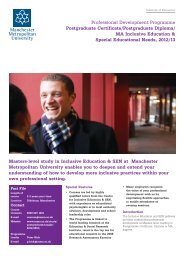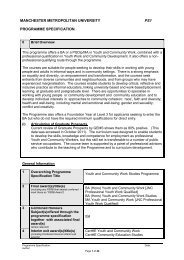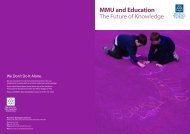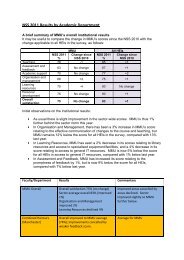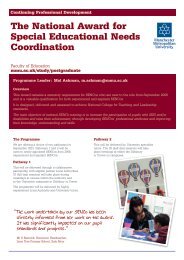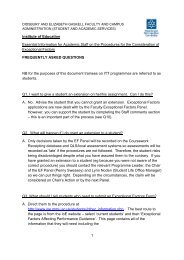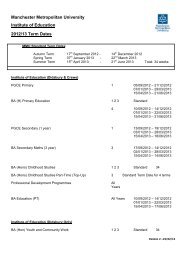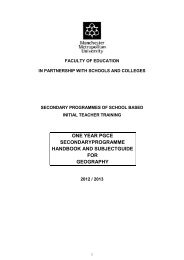here - Manchester Metropolitan University
here - Manchester Metropolitan University
here - Manchester Metropolitan University
You also want an ePaper? Increase the reach of your titles
YUMPU automatically turns print PDFs into web optimized ePapers that Google loves.
Case Study Title: "Oldham is for Everybody": Exploring identity and community<br />
cohesion through creativity. Oldham, Greater <strong>Manchester</strong>, UK.<br />
Summary: Creative practitioners use drama-based processes and techniques and<br />
photography to support young people from three schools to explore their individual and<br />
collective sense of identity and community. A values-based enquiry of public spaces in<br />
the local urban environment.<br />
Dates: 2009 - 2010<br />
Case Study of interest to: All agencies concerned with Community Cohesion and/or<br />
work relating to identity and community. Primary School Teachers. Secondary School<br />
Teachers. Local Authority Commissioners.<br />
Programme theme: Community Cohesion.<br />
Developing skills in Communication/Language; Citizenship/PSHE; Photography; Drama<br />
Supporting change and innovation in schools and communities.<br />
Developing professionals to support the creativity and success of learners.<br />
Disseminating practice regionally, nationally and internationally.<br />
Linking research to practice and provide evidence to influence practice.<br />
Commissioned/Funded by: Breeze Hill High School, Grange High School and South<br />
Chadderton High School, Oldham, Greater <strong>Manchester</strong>, UK as part of The Centre for<br />
Urban Education’s Creative Partnerships Change Schools Programme, UK.<br />
Link to School Improvement Plan/School Evaluation Form:<br />
The three participating schools had worked with Creative Partnerships in England’s North<br />
West (delivered by the Centre for Urban Education) individually since 2008 as part of the<br />
Change Schools programme, but were faced with many shared challenges which were<br />
expected to result from an authority-wide school restructuring plan, featuring mergers and<br />
relocation.<br />
To a large extent "community cohesion" had originally been conceived by the Government<br />
specifically as a response to the social problems which had, according to official reports<br />
(Ritchie, 2001; Cantle, 2001 & 2006), given rise to the so-called "Oldham riots" of 2001<br />
(as well as to similar events in other towns such as Burnley and Bradford).<br />
Key factors in the outbreak of violence were notions of "parallel lives", a lack of social<br />
mobility and self-segregation along ethnic lines and according to relative income. The<br />
school restructuring programme would t<strong>here</strong>fore seek to bring together White and Asian<br />
children from the poorest districts of the town in newly-built schools which would be<br />
located in such a way that more affluent (middle class?) parents may also consider<br />
sending their children t<strong>here</strong>.<br />
The project which forms the focus of this Case Study originated in a shared belief<br />
amongst the three schools that funding and other resources would best be used<br />
collectively in the light of their shared challenges relating to "community<br />
cohesion", and that our aim should be to help prepare their pupils for the<br />
changes ahead.
Who was involved?<br />
2 Creative Agents: Richard Shotton & Noah Rose<br />
(research, planning, co-ordination, management)<br />
3 Schools in the UK<br />
Breeze Hill High School (12 pupils)<br />
Grange High school (12 pupils)<br />
South Chadderton High School (12 pupils)<br />
One Cultural Organisation: Peshkar Theatre Ltd - design<br />
and delivery of drama-based activities<br />
Young People’s<br />
Involvement<br />
2 Evidence Gat<strong>here</strong>rs:<br />
David Eaton & team (photographer) - design and delivery of<br />
photographic activities & Ray Baxter (Turning Tides Ltd) -<br />
design and delivery of values-based reflective activities<br />
Young people were initially consulted through three focus<br />
group interviews (one in each school, with groups of four<br />
pupils) to identify their personal geographies (places w<strong>here</strong><br />
they go/don't go) to help identify locations for a photoshoot.<br />
They then took part in a series of drama-activities (12 pupils<br />
from each school) which aimed to explore notions of identity,<br />
values and "place", and a photoshoot in Oldham town centre,<br />
UK.<br />
Finally some participants (four pupils from each school) met<br />
up again to reflect on their photographs and experiences of<br />
working together as a contribution to evaluating the work done<br />
so far.<br />
Teachers’ Involvement<br />
Aims and objectives<br />
Deputy-head teachers at each of the three schools took a<br />
central role in planning throughout the project, setting<br />
objectives, helping to shape activities, and taking key<br />
decisions about numbers of pupils to be involved and time<br />
questions (e.g. when? how long?).<br />
[see above for long explanation of contextual background from<br />
which this project emerged]<br />
Perceived benefit (outcome requested by teachers) was for<br />
pupils to spend enjoyable time with other young people who<br />
they did not know. Further to this was the hope that pupils<br />
might begin to develop a more complex understanding of<br />
"identity" (their own and that of other people) as fluid and<br />
plural rather than fixed and monolithic, and also that they<br />
might begin to reflect on the idea of "community" as being<br />
grounded in the sharing of values in a certain location (eg.<br />
Oldham town centre).
Programme Description Pupils first met for three days in December 2009. Initial work<br />
took place at the City Learning Centre at South Chadderton<br />
High School, UK for drama activities and training in<br />
photography techniques, and then again for editing and some<br />
initial analysis of photographic outcomes and project impact.<br />
Oldham town centre was the outside location for their<br />
photoshoot.<br />
The drama activities enabled pupils to explore their own reality<br />
and other alternate possibilities from within their own<br />
imagination or the experience and imagination of others.<br />
The photography project enabled them to explore locations of<br />
"inclusion" and "exclusion" of people from "different<br />
backgrounds" (age, religion, gender, wealth etc), and to<br />
stimulate discussion of what might constitute and encourage<br />
or discourage "meaningful interaction" between "different"<br />
people.<br />
Impacts / outcomes /<br />
milestones<br />
Much of this latter phase of reflection and discussion took<br />
place in an event which brought some of the original<br />
participants together again in June 2010 for an evaluation<br />
afternoon.<br />
The impact of this programme includes:<br />
For the pupils: To spend time together and form positive<br />
relationship. Pupils spoke of how the need for teamwork in the<br />
shared tasks (photography and drama) ensured that t<strong>here</strong><br />
was "meaningful interaction".<br />
Pupils also developed photo skills, through which they gained<br />
a new awareness of Oldham, looking at the town in a "more<br />
mature" way, no longer "like kids playing in the park", not<br />
thinking about the world around them, but now curious about<br />
what the park means and represents, why they like going<br />
t<strong>here</strong>, and why any of this matters.<br />
The project saw the beginnings of an awareness amongst<br />
pupils of the notion of "public space", a wider appreciation of<br />
diversity (not only as an ethnic issue but also to include age,<br />
gender, upbringing, and wealth). Through their own<br />
photography and reflection pupils began to understand how<br />
certain locations are more (or less) inclusive than others,<br />
either welcoming everybody, just some or only a select few.<br />
Pupils recognised that places they thought of as "public" (such<br />
as the town centre shopping mall) are in fact private, set up<br />
primarily to serve the private commercial interests of their<br />
owners rather than the public. Pupils recognised this in the<br />
mall's policy against the homeless (barred entry to the building<br />
because they have no money to spend) and against the taking<br />
of photographs (ownership of commercial rights).
Pupils also spent time discussing what makes for (or hinders)<br />
"meaningful interaction" between diverse people, and showed<br />
a strong understanding of their own fears (they would<br />
generally only talk to unfamiliar young people if they could<br />
"predict" how those people might react), and the problem of<br />
who should take the first risky step forward to extend trust.<br />
Resources<br />
Created/Available<br />
What’s next?<br />
Main Contacts<br />
For the professional practitioners: Learning through this<br />
project that creativity (drama/photography) successfully<br />
provides the freedom for young people to explore identity from<br />
new/different perspectives, and developing confidence that<br />
the approach works, based on sound research and<br />
methodology. T<strong>here</strong> are some challenges, however, hopefully<br />
to resolve during the next project phases. Perhaps the most<br />
important is the issue of scale: we have worked with just 36<br />
pupils from three schools so far, compared to the thousands<br />
who will experience either a school merger of relocation in the<br />
near future. We want to scale up our successful project and<br />
test delivery on a larger/wider scale.<br />
Several thousand photographs, available in a range of edited<br />
packages (computer-based or print format - photos were sent<br />
to India to form part of an exhibition); events were captured on<br />
video, available in a 5- and 10-minute edit – see contact<br />
details below for further information.<br />
The project will continue through 2010-11, with plans to<br />
extend involvement to larger numbers of pupils and schools,<br />
and to make greater use of new media and Information<br />
Communication Technology through existing and additional<br />
partners as we seek to engage with the wider community.<br />
These ideas emerged from a consultation exercise with<br />
teachers, potential creative partners and local authority<br />
representatives in the UK in March 2010. A similar<br />
consultation with young people is proposed for late 2010.<br />
The project forms the focus of a PhD study being conducted<br />
by Richard Shotton. The findings were presented at a Centre<br />
for Urban Education event at The Lowry, UK on 8 July 2010,<br />
and also at an international conference in Iran on<br />
"Multiculturalism and diversity in an age of globalisation" in<br />
late July 2010. It is likely to feature in further conference<br />
presentations and published articles in 2011.<br />
For further information and to commission Community<br />
Cohesion programmes: Richard Shotton, Centre for Urban<br />
Education, <strong>Manchester</strong> <strong>Metropolitan</strong> <strong>University</strong>, UK.<br />
Tel: +44(0)161 921 8081 Mobile: +44(0)7786 328115 Email:<br />
rsh@i-globe.org



